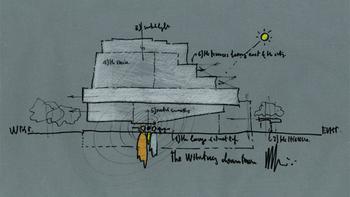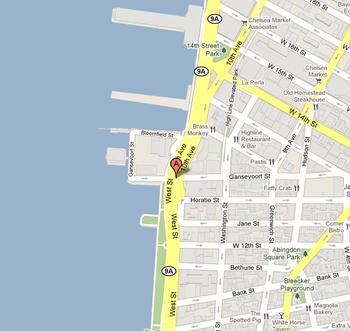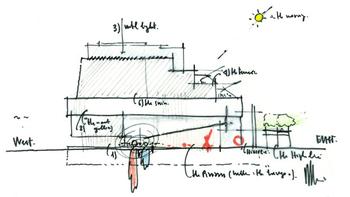The Whitney Museum of American Art breaks ground on Tuesday on its new home: an edgy new building designed by Renzo Piano in the Meatpacking District. The museum has spent the past 45 years on the Upper East Side at Madison and 75th Street. After The Whitney moves out of its landmark Breuer building in 2015, The Metropolitan Museum of Art will move its modern and contemporary art galleries in.
Once it's completed, The Whitney's new 200,000-square-foot museum will sit on Gansevoort Street between West Street and the High Line and overlook the Hudson.
"You'll have these great views over the Hudson and looking out west. And you'll also have these great views into the city towards the Empire State Building and into the urban environment. These are two of the great sources of inspiration for American artists," said Adam D. Weinberg, The Whitney's director, a few days before construction started for the new building. "The Whitney, in a way, becomes a bridge between the urban and looking out to the great open space."
The renderings for Piano's new six-floor white structure include an 18,000-square foot exhibition gallery — the largest column-free gallery in the city, according to The Whitney.
Although the museum's new space will still be smaller than floorplans of other museums in the city, it will be three times the size of its galleries at the Breuer building, which clock in at 32,000 square feet.
"The thing that we pride ourself on is the fact that The Whitney Museum is an intimate museum," said Weinberg. "It's a museum you can get your arms around. It's a place that you can see most of it during one visit."
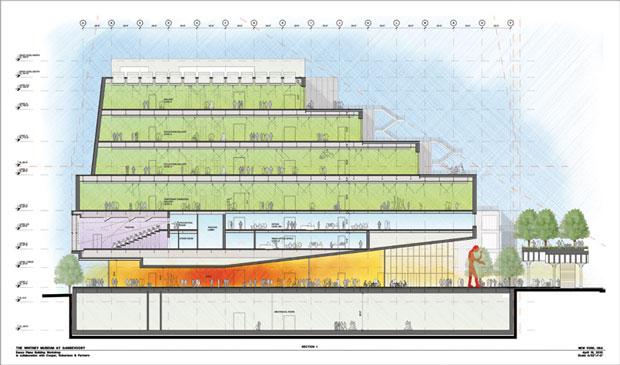 In addition to more square footage, The Whitney's new space also features some 15,000 square feet of outdoor galleries, which will be treated more like the High Line — a place for outdoor events and activities — than like an outdoor sculpture gallery. Plus, since there's only one existing structure on the project's south side, there will be plenty of light by which to check out the art.
In addition to more square footage, The Whitney's new space also features some 15,000 square feet of outdoor galleries, which will be treated more like the High Line — a place for outdoor events and activities — than like an outdoor sculpture gallery. Plus, since there's only one existing structure on the project's south side, there will be plenty of light by which to check out the art.
"The extraordinary thing is the light that one gets from being in an open space," Weinberg said. "So many museums in New York are completely surrounded by buildings."
The Whitney selected Piano, a native of Italy, to create its new space due to his many years of experience designing museums. Piano's responsible for the Beyeler Foundation Museum in Switzerland, the expansion of the High Museum of Art in Atlanta, and The Menil Collection in Houston, among others. And, he's currently working on a major expansion of the Kimbell Art Museum in Fort Worth, Texas.
Piano's New York portfolio includes The New York Times building on Eighth Avenue and the expansion and renovation of the Morgan Library. In addition to The Whitney, the Pritzker Prize–winning architect is also working on a master plan for the extension of Columbia University.
Although he has offices around the world, one of Piano's workrooms happens to sit across the street from The Whitney's Gansevoort site.
"So this means for sure he has to keep his eye on every detail of the building," Weinberg said.
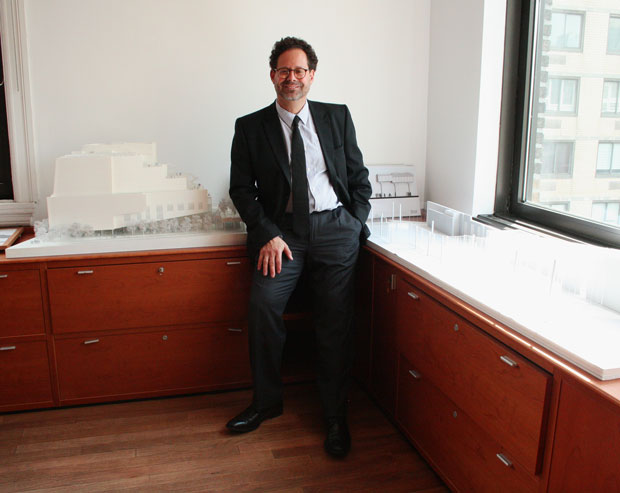 Moving downtown, in a sense, is a return to The Whitney's roots. The museum was founded in 1930 on 8th Street in Lower Manhattan. Operations moved uptown in 1966 to The Whitney's current museum at Madison and 75th, which Marcel Breuer designed.
Moving downtown, in a sense, is a return to The Whitney's roots. The museum was founded in 1930 on 8th Street in Lower Manhattan. Operations moved uptown in 1966 to The Whitney's current museum at Madison and 75th, which Marcel Breuer designed.
"When we opened that building, we had 2,000 works of art," said Weinberg (pictured in his office at left). "Today, we have close to 20,000 works of art."
Much of that permanent collection will go on view during the museum's first major show in 2015 at its new Meatpacking District headquarters.
Although The Whitney will be moving far from Museum Mile, which stretches along Fifth Avenue from 82nd Street to 105th Street, Weinberg said he firmly believed the new center of contemporary art was downtown.
"You have the whole gallery district, which is probably the largest gallery district in the world," he said, along with other cultural hubs downtown including The Kitchen, the soon-to-be-constructed Dia Art Foundation building, White Columns, 92YTribeca, N.Y.U., the School of Visual Arts, F.I.T., and the New School. What is missing in the Meatpacking District, Weinberg said, was a large cultural educational anchor like The Whitney.
"We become a gathering place for the community and a place where people can do things in the evening other than eat and drink — go to a lecture, go to a film, see a performance," he said. "And we're talking about having actually very late hours sometimes during the week because people are out much later in that neighborhood. So, conceivably, the museum could be open till 10 or 11 P.M. on a Saturday night, which would be quite interesting."
The Whitney has been planning its new Gansevoort project for the past four years. A $131 million grant from the museum's chairman emeritus, Leonard A. Lauder, kicked off its fundraising campaign and to date, 70 percent of funds needed, or around $500 million, have been raised to build and operate the new building. The Whitney has also gotten support from the city, which it is acquiring the Gansevoort site land from, and from the state.
Weinberg hopes all the money and hard work will pay off and that the new Whitney, like the High Line plants grown from seeds that fell off railroad trains, will be home to wonderful, diverse art.
"Hopefully, the museum will be a fertile place for a lot of great contemporary art," he said.
The Whitney Museum of American Art breaks ground in the Meatpacking District on Tuesday, May 24. It hopes to complete the project by 2015, at which point The Whitney will relocate downtown. The Metropolitan Museum moves its modern and contemporary art into the Breuer building in 2015 and will occupy the space for at least eight years. The Met has an option to renew the agreement in 2023.
Learn more about the new site in the video to the right or by clicking the slideshow below.
